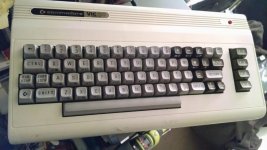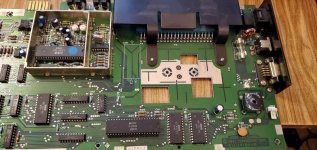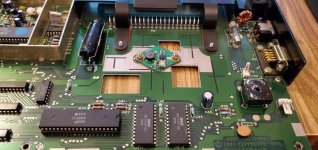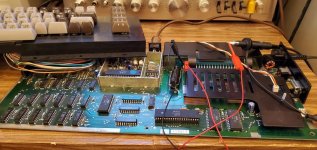CommodoreZ
Experienced Member
A few years ago, I acquired a pile of VIC-20s in various states of disrepair, some relegated to parts machines. Using chips harvested from dead 1541 drives, an NOS C16 keyboard, and a few other bits and pieces, I was able to build one functional VIC to add to my collection. A frankenVIC if you will.

One thing that always concerns me is running Rev E motherboards for too long, due to the heat they start to generate. A few months ago, I saw some project on hackaday (I think it was hackaday anyway) creating switching power regulators to drop right into TO-3 sockets. I forgot about it for awhile, but it came to mind again recently, and it dawned on me that a VIC-20 would be an ideal test case for such a device.
I went searching and ended up finding a company manufacturing a variety of parts fitting into the same technological niche. So I bought a few, and cracked open the aforementioned VIC-20 to extract the 5V linear regulator.

Nearly forgot about the corroded positive terminal on the 4700μF 16V capacitor, so might as well pull that while I'm at it. Don't need that big heatsink either, that can go. When I find the screw for the bridge rectifier's heatsink, I'll put that back on.

That wasn't so bad. Not happy with the temporary capacitor replacement on there, didn't have that value in stock so I did some cap math and got pretty close.
I did one brief test before I went to bed last night, and it powers up. Next step is to check the ripple on the 5V rail to make sure it's reasonably low. Glitch recommended that I throw a tantalum capacitor on there if it's a problem, and that should work fast enough to combat the ripple. After that, it's time for extended operational tests and monitoring with a temperature probe.
Have any of you tried similar linear to switching upgrades on Commodore machines? Success stories, failures, etc. are all welcome.

One thing that always concerns me is running Rev E motherboards for too long, due to the heat they start to generate. A few months ago, I saw some project on hackaday (I think it was hackaday anyway) creating switching power regulators to drop right into TO-3 sockets. I forgot about it for awhile, but it came to mind again recently, and it dawned on me that a VIC-20 would be an ideal test case for such a device.
I went searching and ended up finding a company manufacturing a variety of parts fitting into the same technological niche. So I bought a few, and cracked open the aforementioned VIC-20 to extract the 5V linear regulator.

Nearly forgot about the corroded positive terminal on the 4700μF 16V capacitor, so might as well pull that while I'm at it. Don't need that big heatsink either, that can go. When I find the screw for the bridge rectifier's heatsink, I'll put that back on.

That wasn't so bad. Not happy with the temporary capacitor replacement on there, didn't have that value in stock so I did some cap math and got pretty close.
I did one brief test before I went to bed last night, and it powers up. Next step is to check the ripple on the 5V rail to make sure it's reasonably low. Glitch recommended that I throw a tantalum capacitor on there if it's a problem, and that should work fast enough to combat the ripple. After that, it's time for extended operational tests and monitoring with a temperature probe.
Have any of you tried similar linear to switching upgrades on Commodore machines? Success stories, failures, etc. are all welcome.





